Kanji for Small, Tiny, Slight: 小
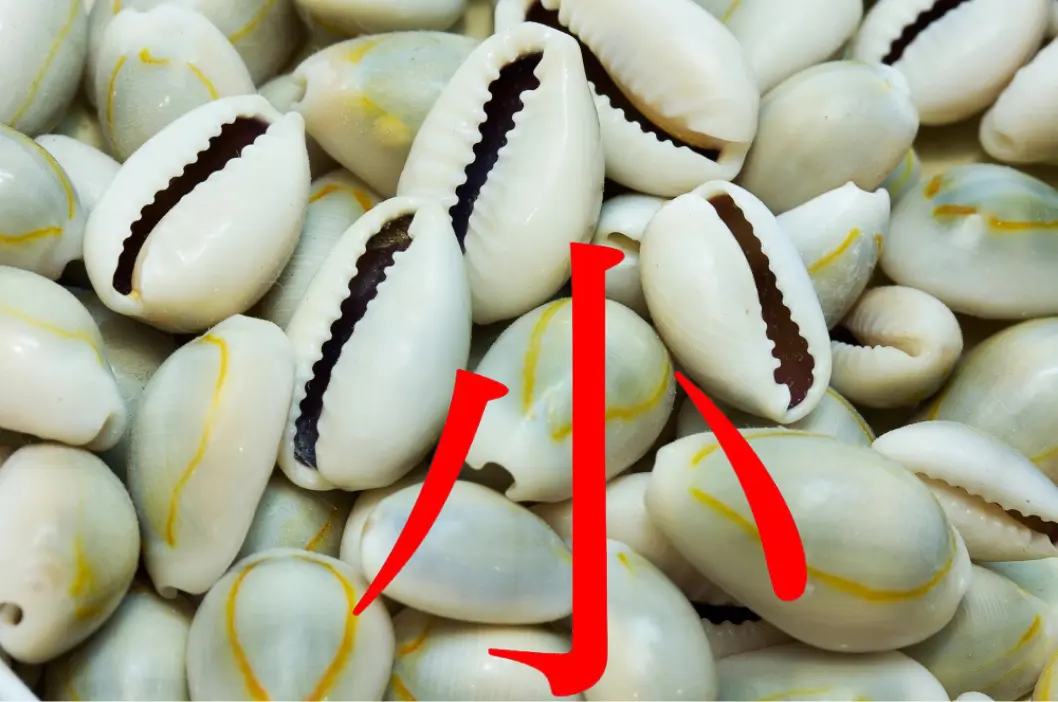
The Japanese kanji for “small” is 小, which also means “Tiny” or “Slight“.
The kun’yomi (Japanese reading) pronunciation of the Kanji 小 are “o” (お), “ko” (こ), or “chii-sai” (ちい-さい). The on’yomi (Chinese reading) pronunciation of 小 is “sho” (ショウ).
The Kanji 小, meaning small, appears in 10,140 Japanese names, and in that case, it is pronounced as “isara” (いさら), “kou” (こう), “saza” (さざ), “shao” (しゃお), or “chiisa” (ちいさ).
Please note that 小 mainly refers to small size or lesser degree in terms of physical dimensions, age, or scale. It’s used to describe something small in size, young, or of lesser importance. When the emphasis is on the physical size or the metaphorical “smallness” of something rather than quantity, 小 is used. For example, 小 can mean little or minor if we refer to the size, age, or scale, not quantity.
The Kanji 小 is constructed with 3 strokes. It is a part of the JLPT N5 syllabus (please check the list of JLPT N5 Kanji) and is taught in grade 1 in Japanese schools.
Origin of the Shape 小
If we see the old shape of the Kanji 小 in the Oracle Bone Script, it depicts three small dots or lines.
Let’s see the evolution of the shape of the Kanji, meaning “small” or “slight,” from ancient times to the current:
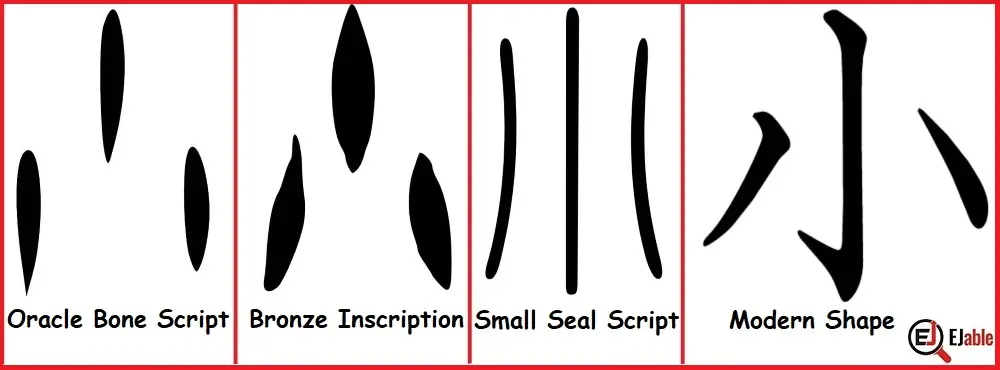

The above image shows the historical shape of 小 in Oracle Bone Script, Bronze inscription, small seal script, and how we write it in the present.
Looking at the three small dots or lines of the shape of 小 in the Oracle Bone Script, it is easy to conclude that those three small lines depicted smallness. However, according to Shizuka Shirakawa (April 9, 1910 – October 30, 2006), who is famous for his extensive research on Kanji and is considered an authority, these three lines depicted three cowries.
Why Cowries to Depict Smallness?
Shizuka Shirakawa’s thoughts that ancient people used cowries to depict smallness are quite abstract but plausible. To get into the depth of it, we must know the importance of cowries in ancient times.
Cowries had tremendous significance, especially in East Asia, South East Asia, and Africa, in the olden days. These significances were not limited to culture and the usage of these shells for ornamental purposes; cowries were also used extensively as shell money.
We all know that Kanji characters are a combination of pictograms representing physical objects and also ideograms where ideas become characters. Therefore, it is natural that small cowries, which touched many aspects of life, may be used as ideograms for some Kanji characters.
Mnemonic: How to Remember the Kanji for Small (小)
While the Oracle Bone Script shape of 小 can easily be associated with smallness, the modern shape of 小 has a big line at the center. This evolved shape may make it difficult to relate this Kanji to something small.
Therefore, let’s create a mnemonic based on Shirakawa’s interpretation of cowries. Remember the expression “small is beautiful”? We can also expand this to represent cowries as small things that are valuable.
A picture as a mnemonic always makes it easier to recall the information. Therefore, let’s use the following illustration as a mnemonic to remember the Kanji for small, i.e., 小:
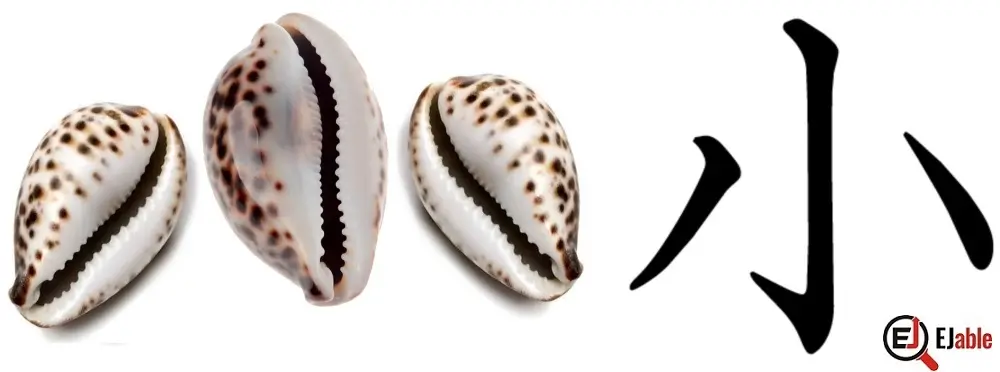

Stroke Order for the Kanji 小
The following illustrations show the order of the 3 strokes to write the Kanji 小:
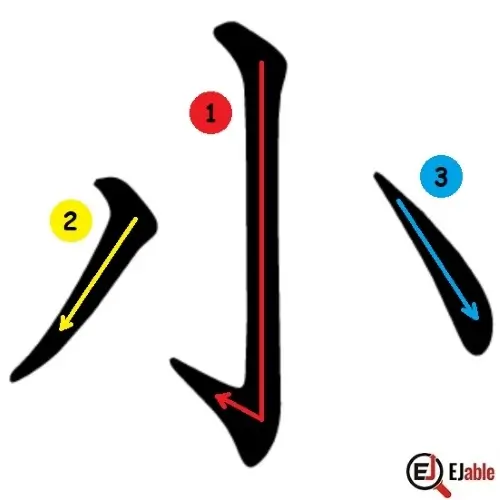

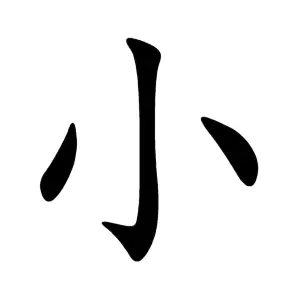

Kanji 小 as a Radical or Component
The Kanji 小 appears as a Kanji radical and component in 398 Kanji characters, out of which 68 are Jōyō (commonly used) Kanji.
Example of 小 as a Radical or Component
Following are the examples where the Kanji 小 appears in other Kanji characters either as a component or a radical:
- 少 [suku-nai (すく-ない) / suko-shi (すこ-し) / sho (ショウ)]: a little, few
- 京 [kyo (キョウ) / kei (ケイ)]: capital
- 歩 [aru-ku (ある-く) / ayu-mu (あゆ-む) / fu (フ) / bu (ブ) / ho (ホ)]: walk
- 変 [ka-eru (か-える) / ka-waru (か-わる) / hen (ヘン)]: change, vary, alter, abnormal, unusual
- 光 [hikari (ひかり) / hika-ru (ひか-る) / ko (コウ)]: light, sunshine, to shine, twinkle
- 歳 [sai (サイ) / sei (セイ)]: X years old, year-end
- 示 [shime-su (しめ-す) / shi (シ) / ji (ジ)]: show, display, indicate
- 願 [nega-u (ねが-う) / gan (ガン)]: wish, hope, petition, request
- 県 [ken (ケン)]: prefecture
- 察 [satsu (サツ)]: inspect, investigate, guess, surmise
- 省 [kaeri-miru (かえり-みる) / habu-ku (はぶ-く) / sho (ショウ) / sei (セイ)]: to omit, leave out, ministry, introspect
- 禁 [kin (キン)]: prohibition, ban
- 恋 [koi (こい) / koi-shii (こい-しい) / ko-u (こ-う) / ren (レン)]: love, darling, beloved, to long for
- 秒 [byo (ビョウ)]: second
- 際 [kiwa (きわ) / sai (サイ)]: edge, occasion
- 療 [ryo (リョウ)]: cure, heal, treat
- 砂 [suna (すな) / sa (サ) / sha (シャ)]: sand
- 涼 [suzu-shii (すず-しい) / suzu-mu (すず-む) / ryo (リョウ)]: cool, refreshing
- 赤 [aka (あか) aka-i (あか-い) / aka-ramu (あか-らむ) / aka-rameru (あか-らめる) / shaku (シャク) / seki (セキ)]: red, to tund red, to blush
Kanji 小 in Compounded Words
The kanji 小 appears commonly in Japanese and forms part of many compound words. There are 741 Japanese words that begin with the Kanji 小, and it appears in 947 words.
Examples of Kanji 小 in Compounded Kanji Characters
Following are the examples where the Kanji 小 appears in Japanese compounded Kanji characters:
- 小学校 (しょうがっこう / shōgakkō): Elementary school.
- 小川 (おがわ / ogawa): Brook, small stream.
- 小説 (しょうせつ / shōsetsu): Novel, short story.
- 小麦 (こむぎ / komugi): Wheat.
- 小包 (こづつみ / kozutsumi): Parcel, package.
- 小切手 (こぎって / kogitte): Cheque, check.
- 小指 (こゆび / koyubi): Little finger.
- 小鳥 (ことり / kotori): Small bird.
- 小売 (こうり / kouri): Retail.
- 小路 (こみち / komichi): Lane, alley.
- 小数 (しょうすう / shōsū): Decimal, fraction.
- 小児科 (しょうにか / shōnika): Pediatrics.
- 小遣い (こづかい / kozukai): Pocket money, allowance.
- 小柄 (こがら / kogara): Small stature.
These compound words showcase the versatility of 小 in expressing various concepts related to physical size, scale, or the degree of something being small or lesser.
Note: Check other Kanji characters on the page “How to Remember Kanji“.


A long-term ex-pat in Japan, Himanshu comes with an IT background in SAP consulting, IT Business Development, and then running the country operations of an IT consulting multinational. Himanshu is the co-founder and Managing Director of ReachExt K.K. and EJable.com. He is also an Advisory Board Member of a Silicon Valley AI/IoT startup.

